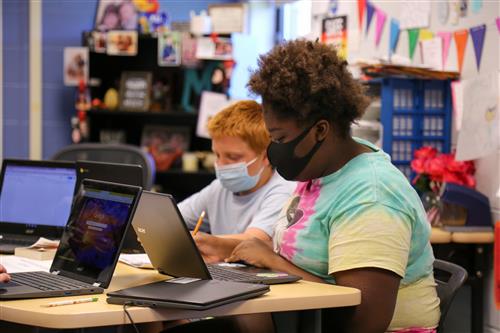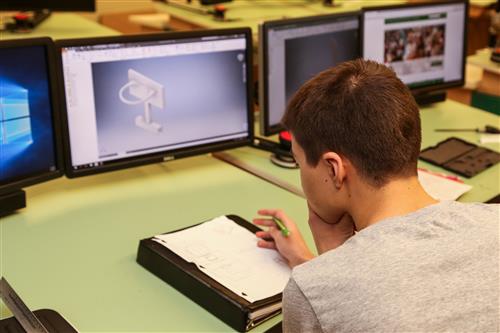Learning Connection
Page Navigation
Technology is integral to every person’s life. How is Blue Valley safely incorporating it into the lives of students?
Heather and Michael Jones grew up at a time when technology wasn’t prevalent. The same can’t be said for the Jones’ six children. Students having access to devices, whether it’s at home or school, is crucial.
The Jones have two children currently enrolled in Blue Valley — a freshman and senior — and four who are Blue Valley graduates.
Families, like the Jones, with the help of online and school resources, can learn how to manage their children’s device use and promote safe technology use.
Blue Valley’s focus on digital citizenship is vital to ensuring students in and outside of the classroom are knowledgeable about the safest ways to use technology.
Digital citizenship is about making sure students are making good choices online, said Brad Moser, Blue Valley’s Director of Blended Learning.
It’s not a new concept. Digital citizenship has been taught for years but the idea has evolved through the years as technology has become integral in peoples’ lives.
How families go about practicing digital citizenship and safe internet use is customized and differs depending on the needs of their kids.
“Our philosophy has always been early on when they have these devices we want to be fairly strict but we’ve also got to teach them how to manage themselves by the time they do leave the house,” Michael Jones said. “We don’t want to be so strict then they leave the house and they have this powerful tool they’ve never navigated before. It’s a tough balance.”
Technology and the internet can be a scary road to navigate, especially when families might not know what their children are using their devices for.
“They could be bullied, they could be bullying,” Michael Jones said. “In some instances, we just give them this phone and it can be, maybe not physically damaging, but damaging in so many other ways without going through the proper steps. It’s something that is new for us to navigate and it can also bring you closer with your kids.”

Teaching digital citizenship
Blue Valley teachers, including librarians and paraprofessionals, are encouraged to teach and design engaging lessons about digital citizenship and technology.
Shannon Troutman, a librarian at Stanley Elementary, is just one of Blue Valley’s staff members teaching students about digital citizenship and internet safety.
Troutman teaches digital citizenship lessons to K-5 students and works closely with Stanley’s Science, Technology, Engineering, Arts and Math (STEAM) paraprofessional to incorporate those lessons into classes.
Troutman said the lessons focus on making good choices with screen time and finding a balance between technology use and engaging and educational activities that can take place indoors and outdoors.
Students also learn password safety and what to do if they encounter cyberbullying.
“I think our kids are being exposed to technology at a much earlier age whether that be here at school because we are using iPads or Chromebooks or more and more of our kids are getting cellphones,” Troutman said. “I feel like it is important for them to know and understand how powerful that tool is and the appropriate ways to use it so that we don’t get down a rabbit hole of inappropriate use.”
Tracy Richter, a computer class paraprofessional at Cottonwood Point Elementary, builds lesson plans based on the Common Sense Media curriculum. She also works with the school’s counselor to determine if there are topics in conjunction with technology that might be affecting students.
For example, she recently taught a lesson plan focused on digital citizenship and social-emotional learning.
Richter has also taught students, depending on grade level, about internet safety and digital footprints.
Reminding the older students the amount of responsibility that comes with technology is important, Richter said. She makes sure to remind the younger students about the importance of being nice on the internet.
Troutman finds her older students are most curious about social media and how to appropriately use it.
“Knowing what to do if you come across something that makes you feel uncomfortable I think is so important for these kids, especially as they start moving onto middle school and more are getting social media,” Troutman said.
Collaboration and implementation of device use are key
So what can parents do at home to support and assist the lessons their students are learning in class?
Troutman said open communication and kids being comfortable talking to parents is important.
“If they don’t feel comfortable coming to a parent, talk to them about who at school you could go to, what adult can you talk to if you see something that makes you feel uncomfortable,” Troutman said.
One of the biggest ways parents can support internet safety at home is by being a good digital citizenship role model.
“It’s good for us to teach our children correct principles with all things, including digital citizenship, then let them govern themselves,” Heather Jones said. “But it’s important as parents to walk that same walk.”
Setting boundaries and limits on device use can be beneficial.
“The goal is to partner with kids,” Moser said. “We want to empower them because they will be like us one day and be independent.”
Avoiding device use in the bedroom and into the evening, especially when trying to prepare to go to sleep is also crucial, Moser said.
Devices can be an endless distraction especially when kids are trying to sleep. But these decisions are dependent on each family’s needs, and plans set in place can be reevaluated as their kids get older and more independent.
“Eventually we want the training wheels to be off, we want them to be able to ride and fly themselves,” Moser said. “Each family has to make those decisions for themselves.”
Allowing for self-regulation will benefit students as they move onto college and careers.
“If they know how to self-regulate, they know there’s time to play video games and time to work on a research paper,” Moser said. “Parents and teachers can help build that self-efficacy for students to know they can be successful and then self-regulate it.”
Families implement their own rules, too, and collaborate with their kids on their plans so they feel empowered.
“We have several different rules or policies that we have with our family that we sit down and talk with them about,” Michael Jones said. “One of them is any electronic device has to be in an open area where others are at. When our kids are doing their homework, they are at the table.”
The Jones talk with other parents to learn about how they handle technology use and adapt their plans as needed.
“We have a couple kids that if you set some sort of technology in front of them, they are going to be on it all day,” Michael Jones said. “We have a couple others who would do exactly as they are supposed to.”

Securly, Common Sense Media valuable tools for parents
Blue Valley uses a variety of tools within the school buildings, many of which parents have access to outside of the classroom’s walls.
Blue Valley uses Securly, a technology that is installed on all school devices and allows for the district to place filters and monitor the usage of devices.
Families can access Securly’s information regarding their children’s devices and receive weekly reports that inform families of what their kids have been doing online.
Common Sense Media is a resource for families that Blue Valley’s teachers have found success implementing into lesson plans.
The website has a section dedicated to parents and information on raising kids in a digital age.
“We use technology to do some really rad stuff and have experiences that we couldn’t before,” Moser said. “It’s pretty powerful. The tools allow us to have some of those engaging pieces and help students personalize their learning. It’s a lot richer than it was without the tool.”
Technology is an integral part of every person’s life. Using devices doesn’t have to carry a negative connotation.
“There are digital skills they are learning,” Moser said. “Those are skills we use in our jobs and professions today from capturing audio recordings to making graphics for marketing. That’s all digitally driven.”

